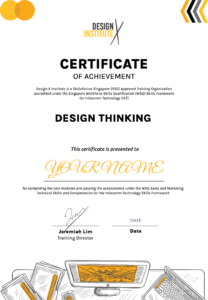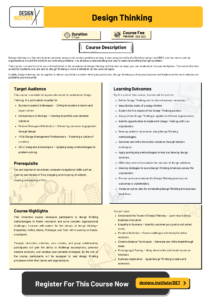Design Thinking
Design Thinking
Upcoming Date & Time
December 15, 2025 - December 16, 2025
9am - 6pm
Duration
2 Days
Course Fee
388 SGD
Course Description
Think of a problem or challenge you had to solve at work recently. How did you approach it? Did you find yourself overwhelmed with the number of possible solutions? Were you unsure how to even start? Design thinking can help.
Design thinking is a five-step human-centered process for creative problem solving. It was popularized by the Stanford school and IDEO, and has been used by organizations around the world to solve knotty problems. It is all about understanding your user’s needs and solving the right problem. By using this human-centered design approach, you can develop products and services that truly help your user.
This course is meant to serve as an introduction to the principles of design thinking and touches on ways you can implement it in your workplace. The material is best suited for students who are new to design thinking or want a refresher on the core concepts. Luckily, design thinking can be applied to almost any field; no matter what your profession, design thinking can help you discover and implement the best solutions to problems you encounter.



Course Schedule
| Learning Mode | Course Dates | Duration |
|---|---|---|
| In-Person | 22, 23 Jul 2025 (Tue, Wed) | 16 Hours |
| In-Person | 15, 16 Dec 2025 (Mon, Tue) | 16 Hours |
Click on the course dates above to register online.





Why Learn at DesignX?
At DesignX, we are passionate in delivering quality training and want to see you succeed. Get expert advice, learning resources, and post-training support for up to 3 years.
Re-attend the Course Within 3 Years
3-year access to the courseware via our LMS
Post-Training Mentoring with Industry Experts

Certification
A Certificate of Achievement will be awarded upon successfully completing at least 75% of the course.

Trainers


Frequently Asked Questions (FAQs)
Yes, this course includes hands-on projects where you’ll apply design thinking concepts to real-world problems, allowing you to practice and reinforce what you learn.
You only need a notebook, pen, and access to a computer or mobile device. Some optional tools include prototyping software or materials for creating physical prototypes, but these aren’t mandatory.
By the end of this course, you will have a solid understanding of the design thinking process, equipped with techniques for approaching problems creatively and collaboratively.
Yes, a completion certificate is available for those who complete all modules and projects, validating your understanding and skills in Design Thinking.
Unlike traditional design courses, this course focuses specifically on Design Thinking, emphasizing empathy, user-centered design, and iterative problem-solving, which are applicable across various fields, not just design.
Yes, you’ll receive feedback on key projects from either instructors or peers to help refine your understanding and application of Design Thinking.
No prior experience is needed. This course is designed to be accessible to beginners, as well as to those looking to expand their creative problem-solving toolkit.
















